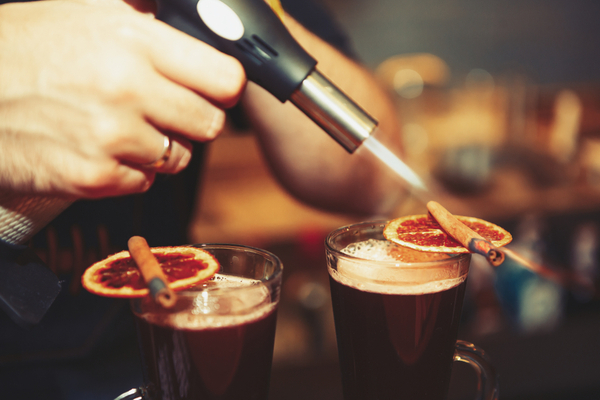There have been savory notes in a handful of traditional cocktails—the tomato juice in bloody marys and olives in martinis, for instance—but bartenders are starting to look to the kitchen for even more inspiration as the boundaries between the kitchen and bar begin breaking down. Below are some innovators who look to blur the lines between the culinary and cocktail worlds.
The collaboration between chefs and bartenders can produce cocktails that pair well with certain menu items and provide ways for using all the ingredients in the kitchen, says Danny Kronfli, co-owner and beverage director of Bacari GDL in Glendale, California. A perfect example is his Duck Fat Sour, a sweet and savory play on both a duck a l’orange dish and whiskey sour. “If the chef is making duck confit, there’s a lot of fat that might be thrown away,” Kronfli notes. Instead, the spiced fat is sous vide-infused in dry orange curacao and added to rye whiskey, lemon, simple syrup, and egg white and garnished with cranberry bitters and cinnamon. And Kronfli has found use in other savory items from the kitchen, like the juice from the roasted beet menu item for a Beeting Heart cocktail, which also has gin, mezcal, jalapeño, lemon, house grenadine, and sea salt.
The concept of fat washing was popularized at PDT over a decade ago with its Benton’s Old Fashioned, made with bacon-fat–infused bourbon, maple syrup, and Angostura bitters and garnished with orange peel. The East Village cocktail lounge uses savory items in other cocktails, too, like the Peeking Duck, which plays on the flavors of the sound-alike Chinese dish. It combines soy sauce, which provides umami, with vodka, cognac, Mandarine Napoleon liqueur, lemon juice, Amaro Averna liqueur, ginger ale, and orange juice. The garnish is half an orange wheel.
Aaron Alcala-Mosley, bar manager at Lineage in Maui, Hawaii, acknowledges he is inspired by the foods he eats. Lineage features several savory cocktails, including the popular Gimme da Chicken Skin, a corpse reviver variant that became more when a manager drank it while eating fried chicken skins. “It was crazy good,” Alcala-Mosley says. The cocktail, served with a side of the skins, mixes cucumber vodka, gin, habanero shrub, and Carpano Bianco vermouth, with some specialty Hawaiian ingredients like false lime, false awa, and shoyu. The restaurant also fat-washes a mezcal in its Panda Xpress cocktail that uses the fat from adobo chicken prepared at a sister restaurant. “It’s an interesting way to approach an umami spirit,” Alcala-Mosley adds. The mezcal is combined with rye, lemon, grilled pineapple shrub, red wine, and egg white.
Cheese, specifically Gouda, is infused in vermouth using a whipped cream dispenser charged with nitrogen as part of the Cacio e Pepe Martini at Better Sorts Social Club in the Kimpton Nine Zero Hotel in Boston. The cocktail, influenced by the classic cheese and pepper pasta dish, also includes vodka and black pepper pasta water syrup. The Gouda provides an undertone of savoriness, says Naomi Levy, beverage director. “Savory is much of what we do on a daily basis in the kitchen, so why should cocktails be different?”
For Caitlyn Jackson, bar director at Geraldine’s in Austin, Texas’ Hotel Van Zandt, the food she eats inspires some cocktails. Gyros at a nearby food truck where the staff goes after a shift was behind the I Can Be Your Gyro, Baby, where Greek yogurt is the key savory ingredient, she says. The cocktail has cucumber gin and blanc vermouth infused with cucumber, dill, mint, and Greek yogurt that is refrigerated for days and strained. This is poured atop a dollop of yogurt, creating something that’s “really silky and sort of coats the tongue, but bright and refreshing.”
Cocktails are increasingly perceived as part of the culinary arts, so bartenders and chefs often work together as a collaboration between the front and the back of the house, notes Eric Smith, head bartender at Kingfisher Bar & Grill in Tucson, Arizona. The restaurant has found various ways to integrate savory notes in its cocktails but not hold up the bar’s efficiency, from the blue-cheese–stuffed olive in the Grover’s Martini to the za’atar-infused gin—a cheesecloth bag filled with spices soaking in the gin for 48 hours—in the Dearborn Tonic. Mi Tio Borracho—translation My Drunk Uncle—features local sweet and sour chiltepin pepper water with tequila, orange curacao, mango, and mint, and the Killer B’s has a basil-beet shrub, along with bourbon, herbal Benedictine, and a basil leaf. “I’m looking to pack a lot of flavor in cocktails without adding steps, which is important on busy nights,” Smith says.
—
Photo Credit: hurricanehank / Shutterstock.com
